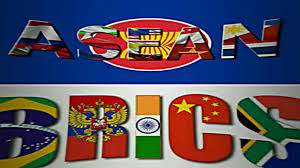We publish here an excerpt from Chan Chian Wen's editorial, which appeared in Nikkei Asia
A common critique of BRICS lacks the cohesion necessary for long-term stability. However, ASEAN's five-decade track record proves otherwise. This group of 10 Southeast Asian economies serves as a real-time case study of how political and economic diversity can coexist while fostering peace and prosperity. ASEAN comprises Muslim-majority, Buddhist-majority, and Christian-majority countries, all with multi-ethnic and multi-cultural societies. These nations don't even share the same political systems. Yet, ASEAN's continued existence and prosperity serve as a powerful rebuttal to the notion that a diverse mix of countries cannot function effectively together. ASEAN's proven record of neutrality has long supported regional stability; now it should extend its influence to help reduce conflict risks beyond its borders. While BRICS aims to foster economic multipolarity, it is often viewed by Washington as aligned with its geopolitical rivals, Moscow and Beijing. ASEAN, without such baggage, is uniquely positioned to ease concerns over BRICS being perceived as anti-Western. ASEAN can also benefit from BRICS's growing commodity exchanges, which provide an opportunity to boost sustainable economic growth and improve food security. By protecting commodity-dependent economies from excessive speculation, BRICS exchanges help mitigate price volatility, a key threat to ASEAN's stability. Furthermore, BRICS countries play significant roles in global supply chains for both raw and value-added commodities. Many experts believe the world is on the cusp of a new commodity super-cycle, driven by decades of underinvestment in resource extraction and refining infrastructure. BRICS, with its significant lead in this space, is well-positioned to cushion the socio-economic fallout of such a cycle -- an advantage that ASEAN lacks. With global trends shifting toward electric vehicles, lithium batteries, nuclear energy, semiconductors and electrification, ASEAN risks falling behind without deeper engagement with BRICS. Additionally, BRICS offers access to alternative platforms for financial transactions, such as blockchain. By linking settlement currencies to neutral reserve assets like gold, ASEAN could reduce its exposure to the risks of sharp fluctuations in the U.S. dollar. For ASEAN to maintain true neutrality, it must adopt a platform-agnostic approach to financial transactions in global trade and investment. In conclusion, it is not in ASEAN's best interest to passively observe attempts to reverse the trend toward multipolarity, including the forging of closer ties between BRICS and ASEAN.






